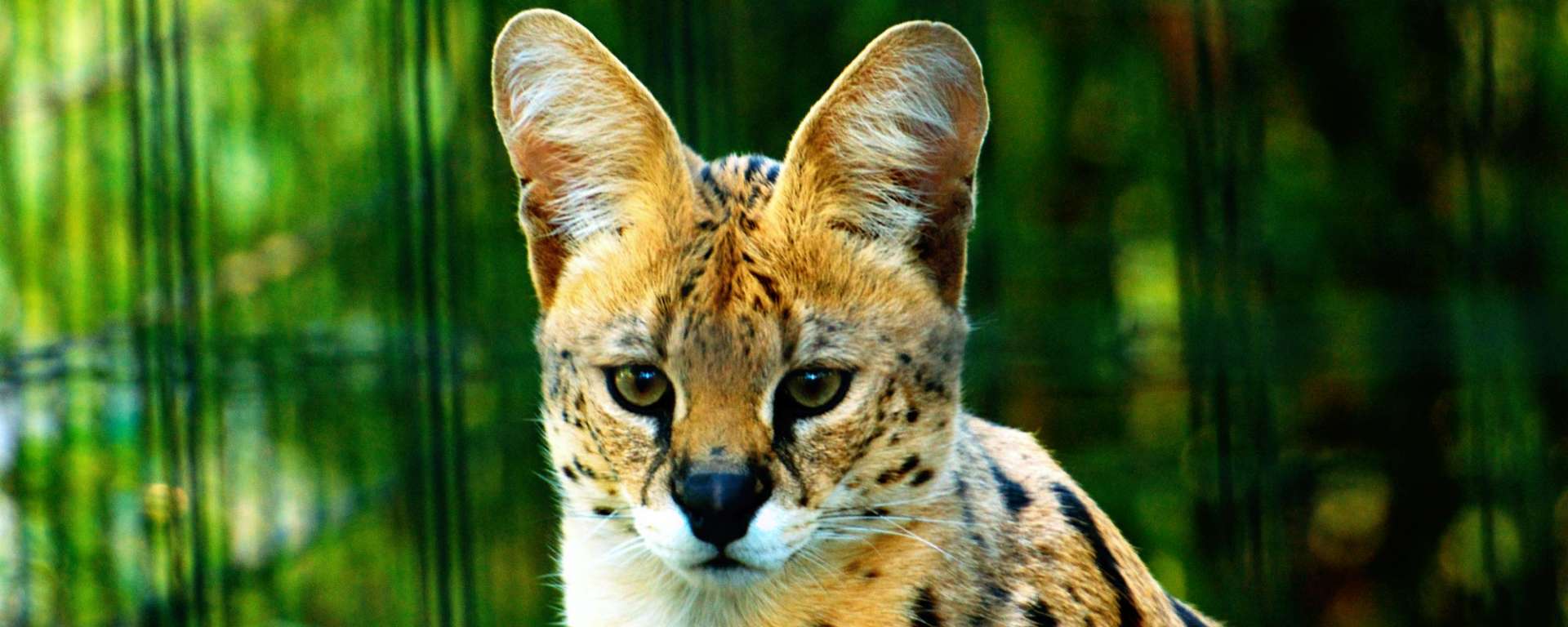Description
Servals are slender, skilled hunters. They have tan coats with spots and strips that act as camouflage in dry grass. Their large, oval ears are the largest in the cat family and allow them to hear prey beneath the ground or in dense grass. Having the longest leg-to-body ratio of any cat gives the serval a vantage point over small prey in the tall grass.
Classification
- Class
- Mammalia
- Order
- Carnivora
- Family
- Felidae
- Genus
- Leptailurus
- Species
- L. serval
- Conservation Status
- Least Concern
Key Facts
- Height
- 18-24 in (~45-60 cm)
- Weight
- 20-40 lb (~9-18 kg)
The IUCN Red List describes Leptailurus serval as a species of Least Concern in the majority of its range. However it is listed as Endangered in North Africa and Rare in the Sahel. In general, the population appears to be stable and they are abundant and widespread south of the Sahara. The greatest threats to the serval are habitat degradation and loss.
Social Life
Occasionally a male and female may travel, hunt, and rest together for short periods, but servals are not typically social cats. They hunt during early morning and late afternoon with females tending to be more active than males.
Habitat and Range
Servals are found in grasslands, wetlands, reed beds, forests, and savannah in eastern and southern Africa, especially in Zimbabwe. Small populations are located in the Atlas Mountains, Algeria, Morocco, and Ethiopia. The population in the Kenyan Mountains has a high number of melanistic, all black, individuals.
Diet
Servals usually hunt in the early morning and evening. Their diet consists primarily of small mammals and birds but also occasionally insects, young and small antelope, snakes, frogs, fish, lizards and carrion. They have been recorded jumping as high as 8-10 feet while attempting to catch small birds and pouncing 10-12 feet horizontally to catch prey on the ground.
Lifespan
Servals are estimated to live 10-15 years in the wild and in captivity on average 22 years.
Predators
African servals have no major predators other than humans. When servals discover they are close to a predator, such as a lion, leopard or hyena, they run away in confusing darting leaps.
Reproduction
Sexual maturity: Male: 18-24 months, Female: 26 months
Mating Season: Year-round, more frequently in spring
Birth Season: Year-round
Gestation: 65-75 days
No. of Young: 2-3 per litter
- Information
-
Description
Servals are slender, skilled hunters. They have tan coats with spots and strips that act as camouflage in dry grass. Their large, oval ears are the largest in the cat family and allow them to hear prey beneath the ground or in dense grass. Having the longest leg-to-body ratio of any cat gives the serval a vantage point over small prey in the tall grass.
Classification
- Class
- Mammalia
- Order
- Carnivora
- Family
- Felidae
- Genus
- Leptailurus
- Species
- L. serval
- Conservation Status
- Least Concern
Key Facts
- Height
- 18-24 in (~45-60 cm)
- Weight
- 20-40 lb (~9-18 kg)
- Conservation
The IUCN Red List describes Leptailurus serval as a species of Least Concern in the majority of its range. However it is listed as Endangered in North Africa and Rare in the Sahel. In general, the population appears to be stable and they are abundant and widespread south of the Sahara. The greatest threats to the serval are habitat degradation and loss.
- Lifestyle
Social Life
Occasionally a male and female may travel, hunt, and rest together for short periods, but servals are not typically social cats. They hunt during early morning and late afternoon with females tending to be more active than males.Habitat and Range
Servals are found in grasslands, wetlands, reed beds, forests, and savannah in eastern and southern Africa, especially in Zimbabwe. Small populations are located in the Atlas Mountains, Algeria, Morocco, and Ethiopia. The population in the Kenyan Mountains has a high number of melanistic, all black, individuals.Diet
Servals usually hunt in the early morning and evening. Their diet consists primarily of small mammals and birds but also occasionally insects, young and small antelope, snakes, frogs, fish, lizards and carrion. They have been recorded jumping as high as 8-10 feet while attempting to catch small birds and pouncing 10-12 feet horizontally to catch prey on the ground.Lifespan
Servals are estimated to live 10-15 years in the wild and in captivity on average 22 years.Predators
African servals have no major predators other than humans. When servals discover they are close to a predator, such as a lion, leopard or hyena, they run away in confusing darting leaps.Reproduction
Sexual maturity: Male: 18-24 months, Female: 26 months
Mating Season: Year-round, more frequently in spring
Birth Season: Year-round
Gestation: 65-75 days
No. of Young: 2-3 per litter

